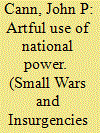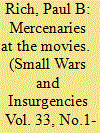| Srl | Item |
| 1 |
ID:
103971


|
|
|
|
|
| Publication |
2011.
|
| Summary/Abstract |
In its colony of Angola, Portugal during its colonial wars (1961-1974) was able to exploit the economic dependence and divided population loyalties of its hostile neighbours the Congo and Zambia as well as the cleavages within the nationalist movements to prevent a crippling insurgency. The rulers of both countries were largely dependent on Angola for trade, and were eager to have the side effects of the robust Angolan economy with its 11% annual growth brush off on their own moribund ones. While relationships were never comfortable, the sponsors of revolution were forced to reign in their 'freedom fighters' in order to maintain the functioning of their export-dependent economies. Portuguese leadership also played a vital role, as it was able to bring together diverse elements of national power in a concerted policy for dealing with these enemies, whether they were insurgents or their sanctuary countries. This policy of leveraging national power and playing on the vulnerabilities of its opponents worked well during its war in Angola and still holds valuable lessons for countries that find themselves in similar circumstances.
|
|
|
|
|
|
|
|
|
|
|
|
|
|
|
|
| 2 |
ID:
188322


|
|
|
|
|
| Summary/Abstract |
This paper examines cinematic representations of mercenaries from the era of silent movies to the 1980s. It argues that cinema has been selective in the choice of historical periods to depict mercenaries and soldiers of fortune, ignoring for the most part the centuries of European state building in which mercenaries played a significant role. Most mercenary films are anchored in the near present and the paper focuses on Mexico and the Congo as terrains of political breakdown and external intervention. Since the 1950s, a range of films depict mercenaries in these terrains seeking money, adventure, and the thrills of killing, and the paper examines mercenary movies through the character structures of hero, anti-hero and villain. These three structures have shaped the portrayal of mercenaries in westerns and war movies as well as action and sci fi movies, where they have become hardened in the last two decades into range of stock stereotypes
|
|
|
|
|
|
|
|
|
|
|
|
|
|
|
|